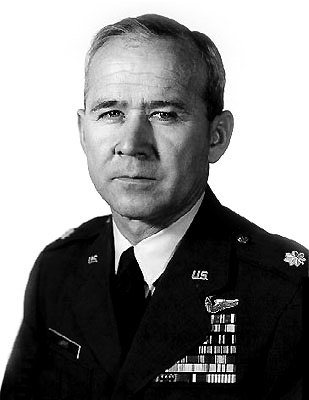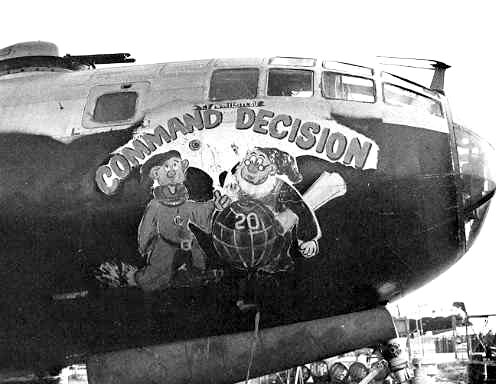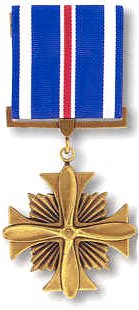By Danny K. Shepherd
 LT. COL. JOHN S. LAPPO photo ctsy John S. Lappo, Jr. |
A Man's man - That's how those who knew Captain John Lappo back in the 50's referred to the pilot made infamous by his aerial assault on the Mackinac Bridge that connects the upper peninsula of Michigan with the lower. The story made headlines across the Midwest, and indeed the country, when news leaked out about the former Elmendorf AFB, Alaska, Executive Officer, flying a 2 ½ million dollar reconnaissance configured bomber, a RB-47E Stratojet, under the world's longest suspension bridge.
It wasn't one of Captain Lappo's 28 bombing runs north of the 38th parallel during the Korean War, or the stealth and skill used to fly and navigate the Soviet Union just to isolate the location of enemy radar's, or his tour of duty in Vietnam that made him infamous, but rather, it was a daredevil feat of gigantic proportions that brought John Lappo to the attention of all the world, or at least to the attention of everyone who lived in the United States, and unquestionably to all who were currently assigned to the Strategic Air Command (SAC).
On 24 April 1959, the brash, confident, daring, highly respected and highly decorated 39-year-old Reconnaissance Aircraft Commander, with 15 years and 5700 hours of flying experience under his belt, wanted to add one more conquest to his long list of accomplishments. He had an inspiration - one that would be fulfilled, and one that would forever change his life as he and his family then knew it.
Born in Muskegon, Michigan in 1920, John grew up dreaming of men and their flying machines. He joined the military from Muskegon in 1943, and completed eight months of pilot training while assigned to the Army-Air Force Flying School in 1944. Upon successful completion of the school, John was awarded his 'Flight Officer' status and was ordered to Clark AFB, Philippines where he eventually transported troops throughout the Pacific to far fetched places like Shanghai, China; Guam, Hawaii, and Japan.
At first Lappo wondered if he'd ever get to fly outside of flying school. He and a few other Flight Officers were initially assigned to the depot at Clark awaiting further assignment to a squadron. Fearful that his flight currency status ran the risk of expiring, he convinced the sergeant-in-charge of the depot to check out a couple of planes to him and his buddies so they could remain flight status qualified. The sergeant insisted on a hand receipt, but John got his planes.
He was commissioned a Second Lieutenant in January 1945 while still in the Philippines and was assigned to the13th Troop Carrier Squadron (TCS), later renamed the 22nd TCS where he flew C-46's, C-54's, and DC-3's in support of troop movements. Promoted to First Lieutenant in July 1946, John continued flying troops throughout the Pacific and later, the European Theater of Operations.
Lappo got out of the service in 1948 and returned to Muskegon, Michigan where he had hoped to fit back into the mainstream, perhaps find a nice girl and raise a family.
His love for flying never waned so it wasn't surprising that John remained in the Active Reserve and retained his Class 'A' reserve flying status following clean-up operations from WWII.
In 1951 however, First Lieutenant Lappo was recalled to active duty with the outbreak of the Korea War.
His first of 28 bombing missions into North Korea originated from the very base where he would spend the next several months of his life, Kadena, Okinawa. Now, 'Captain' Lappo, he opened the bomb bay doors of his B-29 and recounted "bombs away" on strategic as well as tactical targets throughout the war zone, only missing his target on one occasion when controllers failed to vector him onto a target and his fuel ran short causing him to land at Suwon, South Korea, which was then called K-13 and was located approximately 20 miles south of Yongsan Army Base in Seoul.
In fact, Tony Queeno, Lappo's right gunner, fondly recalls the event and associates it with the day baseball great Ted Williams was shot down. He remembers they dispatched helicopters from Suwon sometime after they had landed and all the scuttlebutt recounting the successful rescue that followed. Although his plane was never directly hit by enemy anti-aircraft artillery, stress fractures abounded and shrapnel from the exploding artillery left its mark on the plane on more than one occasion. According to Queeno, the shrapnel from one such onslaught "penetrated through our right wing just missing our wing tank."

Her gunners shot down five jet fighters, three in one confrontation.
She flew a total of 121 missions. USAF
In addition to the Korean Service Medal, John was awarded the United Nations Service Medal, the Air Commendation Medal, and the Asiatic-Pacific Campaign Medal among numerous other decorations and commendations.
Following the Korean War, Capt. Lappo received orders to attend the Officer Squadron School in Montgomery, Alabama. He was granted three days leave and transient time from El Paso, Texas to get there, but John had one very important stop to make along the way. He took a detour via Muskegon, Michigan where he anxiously and excitedly asked his sweetheart, O. Kay Robinson, to marry him. She accepted his proposal and with special permission from the church, they were married the following day. And on the very next day she accompanied him to Montgomery. John was subsequently transferred to Lockbourne AFB, Ohio as a member of the Eighth Air Force's 10th Strategic Reconnaissance Squadron of the 26th Wing, later renamed the 352nd Bomb Squadron of the 301st Bomb Wing, Medium, Strategic Air Command.
It was during this tour of duty that Lappo received the Distinguished Flying Cross (DFC) for his intelligence (PHOTINT and ELINT) gathering role against the Soviet Union.
 Lappo received the Distinguished Flying Cross for his intelligence gathering role against the Soviet Union. |
Although information available from that time indicates that he received his medal for services other than intelligence gathering activities, cover stories such as 'risky' and 'highly sensitive' polar weather reconnaissance missions were used to divert attention from the 'Spy In The Sky' operations that he and his fellow reconnaissance pilots were flying deep into Soviet air space. These missions were so covert, that at times some believe that not even President Dwight D. Eisenhower, or his closest aide, General Andrew Goodpaster were knowledgeable of their existence.
In fact, Eisenhower had forbidden any flights over Soviet airspace at that time, saying they "amounted to acts of war!" At least that was what the public and the rest of the president's staff and cabinet were led to believe. But Ike and his head of the Strategic Air Command, General Curtis E. LeMay, and the Secretary's of Defense and State, all four knew differently.
Early on the morning of 8 May 1954, three RB-47's took off from Fairford, RAFB in Great Britain and flew around Norway to Murmansk. Two of the aircraft returned the way they came, the third, piloted by Capt. Hal Austin, flew south deep into Soviet territory - their objective: to conduct photo intelligence operations against nine different airbases in hopes of isolating Russian long-range bombers. And as an added bonus, possibly detecting for the first time, the operational deployment of Soviet MIG-17 Fresco's. Early into the overflight several MIG-15 Fagot's attempted to identify the intruders as friendly or foe, but because of the RB-47's altitude the 15's were no match for the lofty medium bombers. Just a few minutes later however, before Austin, his Co-Pilot, Carl Holt, and their navigator, Vance Heavilin, knew what hit them, several MIG-17's had engaged them in a hail of cannon fire they likened to hell's fury. They never expected the MIG-17's. The SAC Intel Officers who briefed them prior to departing England knew the possibility existed, but never bothered to tell Austin or his crew. That was the way back then, as it is now, 'the need to know'. The MIG-15's had obviously determined that the SAC bomber was unfriendly. The reconnaissance-configured bomber was shelled, ripping a gashing hole in its skin, and tracers continued to flash by on all sides. Austin, calling upon his training as an aircraft commander, miraculously maneuvered his bomber out of harm's way and back to Fairford.
Austin and his crew were the first to receive General LeMay's explanation why he was giving them the DFC vice a Silver Star, "…You've got to explain that to congress and everyone else in Washington so I'll give you guys a couple of DFC's instead!" What LeMay really feared was global exposure of his 'Spy in the Sky' operations and any possible embarrassment the Commander-in-Chief would suffer should the Soviets be able to confirm their accusations of overflights - acts of aggression!